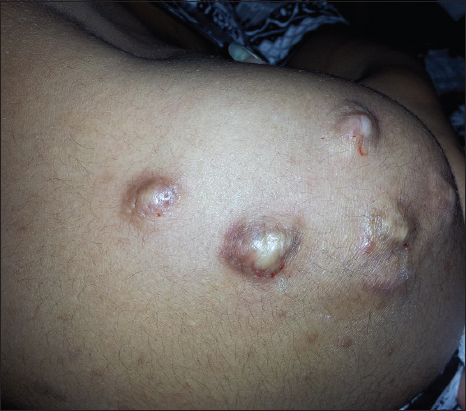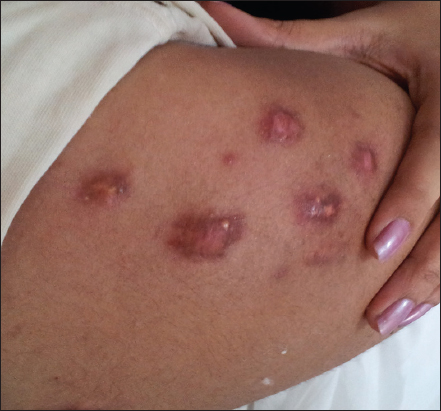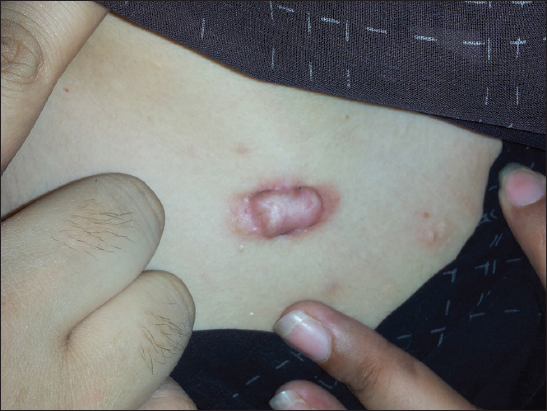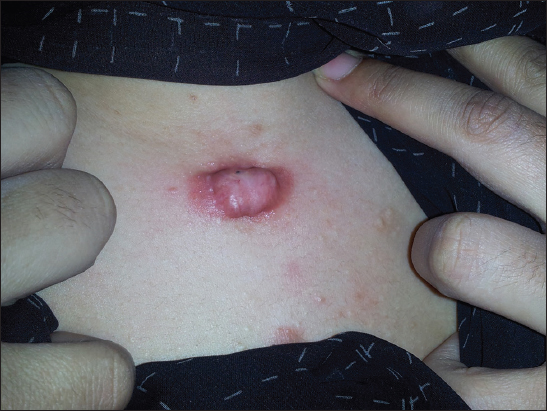Comparison of intralesional triamcinolone and intralesional verapamil in the treatment of keloids
Muhammad Uzair, Ghazala Butt, Khawar Khurshid, Sabrina Suhail Pal
Department of Dermatology, Unit II, Mayo Hospital, Lahore, Pakistan
ABSTRACT
Introduction: Keloid is an abnormal fibrous tissue outgrowth which extends beyond the borders of the wound. Intralesional triamcinolone acetonide is the most commonly used corticosteroid in the treatment of keloids. Intralesional Verapamil is an emerging treatment modality. Both of these drugs were compared to guide us towards better management of keloids by choosing the more appropriate treatment.
Material and Methods: This was a randomized controlled single blind study conducted in the outpatient department of Dermatology unit II, Mayo Hospital Lahore, Pakistan. Eighty patients (40 in each group) were enrolled. Group A was given Intralesional Verapamil injection 1ml (2.5 mg) every month and group B was given Intralesional Triamcinolone acetonide (40mg) monthly. Patients were assessed at the beginning of the treatment and at the end of 3th injection. The clinical assessment of the scar was based on the Vancouver Scar Scale. Mean decrease in total score was calculated and patient’s keloid were photographed with a high quality digital camera, with consent.
Results: Eighty patients, 42 (52.5%) male and 38 (47.5%) female were enrolled. The age of patients ranged from 12 to 40 with a mean age of 25.96 (±6.982) years. Most of the patients were between 21 to 30 years of age group. After the completion of study 58.28% reduction in the baseline score was seen in the triamcinolone group as compared to 36.75% in the verapamil group. Adverse drug reactions observed were pain in almost all patients, hypopigmentation in five patients and irregular menstrual cycles in two females with Triamcinolone. While only pain was observed with intralesional Verapamil.
Conclusion: Intralesional verapamil can be used in the treatment of keloids but intralesional triamcinolone acetonide is better. Intralesional verapamil can give better results when used in combination
Key words: Keloid, Triamcinolone, Verapamil
INTRODUCTION
Keloid is an abnormal fibrous tissue outgrowth which extends beyond the borders of the wound. It does not usually regress spontaneously and possesses high chances of recurrence after excision. Keloids grow faster and become raised and thickened within 3 to 4 weeks [1]. They can occur anywhere on the body but the most common sites are sternum, shoulders, earlobes, and cheeks [2]. They are caused by minor trauma to the skin like ear piercing, abrasion, tattooing, burns, and at the site of injection [3]. It may occur after acne formation or chickenpox infection and sometime keloids can be formed spontaneously in sternal area in susceptible individuals [4].
Treatment of keloids is a difficult and challenging job. It has a high recurrence rate. Different modalities are in practice but none of them either single or in combination give promising results when used [5]. Compression bandages, silicone gel, flavonoids, intralesional corticosteroids injection, Cryotherapy, scar revision surgery, radiotherapy, intralesional interferon injection, bleomycin, 5-FU, methotrexate and laser therapy are used for the prophylaxis and treatment of keloids.
Intralesional triamcinolone acetonide is the most commonly used corticosteroid in the treatment of keloids, which suppresses the inflammatory process in the wound, diminishes collagen and glycosaminoglycan synthesis, inhibits fibroblast growth factors and enhances collagen and fibroblast degeneration [7,8].
Verapamil, an anti-hypertensive, is also used in the treatment of keloids. When administered intralesionally, it reduces extracellular collagen production and stimulates synthesis of collagenases, thus promoting the breakdown of collagen as well [6].
To the best of our knowledge, this was the first study in our country to compare intralesional Verapamil with intralesional Triamcinolone acetonide. The purpose of this study was to compare the efficacy and safety of both the drugs, to guide us towards better management of keloids by choosing the more appropriate treatment.
MATERIAL AND METHODS
This was a randomized controlled single blind study. Sample size of 80 cases (40 in each group) was taken by purposive non-probability technique. Mean decrease in score in both the groups was calculated through Vancouver scar scale. The power of the test was 80% and confidence interval was 95%.
The inclusion criteria for the study were patients from either sex, presented between 10 and 40 years of age; size of keloid more than 1 centimeter to 5 centimeters and on any site of the body; duration of keloid less than five years and baseline Vancouver scar score of 5 or above. The exclusion criteria were pregnancy or lactation; family history of keloids; Patients having diseases like acromegaly, diabetes mellitus and congestive cardiac diseases on the basis of history, physical examination and investigations like blood sugar level, and ECG; presented after thyroidectomy and patients on isotretinoin and anabolic steroids.
Patients having keloids presented to Outpatient Department of Dermatology, Mayo Hospital, Lahore and fulfilled the inclusion criteria were enrolled. Informed consent was taken and the graphic data (name, age, Sex, telephone contact number and address) was charted.
Patients were divided in two groups. Group A was given Intralesional Verapamil injection 1ml (2.5 mg) every month and group B was given Intralesional Triamcinolone acetonide (40mg) monthly. Patients were assessed at the beginning of the treatment and at the end of 3th injection. Administration of the drugs was continued till the keloid flattened or for a maximum period of three months. The patients were followed up three months after the administration of last injection to look for any recurrence.
The clinical assessment of the scar was based on the Vancouver Scar Scale which is universally accepted, standard scale used for scar assessment. The scars were assessed on four parameters namely pigmentation, vascularity, pliability and height
Mean decrease in total score was calculated and patient’s keloids were photographed with a high quality digital camera, with consent.
Data was entered and analyzed in the SPSS version 12. Quantitative variables like age, baseline Vancouver scar score, Vancouver scar score after treatment at three months were calculated in the form of mean +/- S.D. Qualitative variables like gender were presented in the form of frequencies and percentages. t-test was used to compare the mean decrease in Vancouver scar score in both groups. P-value of <0.05 was considered as statistically significant.
Ethics
This study was performed on human subjects; thus, all patients were aware of the presence of the study and they were fully informed about the drug and its side-effects.
RESULTS
Eighty patients, 42 (52.5%) male and 38 (47.5%) female were enrolled in the study from the outpatient department of Dermatology unit II, Mayo Hospital Lahore. All of the patients completed the study.
The age of patients ranged from 12 to 40 with a mean age of 25.96 (±6.982) years. Most of the patients were between 21 to 30 years of age group. The tabulation of age groups and sex distribution is given in Table I.
Table 1: Cross tabulation of age groups and sex
Patients were randomly divided into two equal groups A and B. The gender wise group distribution is shown in fig 1. Intralesional Verapamil was given in a dose of 1ml (2.5mg) to group A and group B was put on intralesional Triamcinolone acetonide, 1ml (40mg). Maximum of three doses, one month apart were given and patients were followed three months after the completion of treatment.
Figure 1: Gender distribution with respect to Group.
Keloids were assessed by Vancouver scar scale before, at the completion and three months after the completion of treatment in both the groups. After the completion of study 58.28% reduction in the baseline score was seen in the triamcinolone group (Figs 2 and 3) as compared to 36.75% (Figs 4 and 5) in the verapamil group. The mean decrease in score after the completion of treatment was calculated and compared. The descriptive statistics of the mean decrease in both the groups is plotted in Table 2.
Figure 2: Before Intralesional Triamcinolone Inj.
Figure 3: After 3rd injection of Triamcinolone.
Figure 4: Before 1st Inj. of Verapamil.
Figure 5: After 3rd Inj. of Verapamil.
Table 2: Descriptive statistics
Adverse drug reactions observed were pain in almost all patients, hypopigmentation in five patients and irregular menstrual cycles in two females with Triamcinolone. While only pain was observed with intralesional Verapamil.
Patients were followed for three months after the completion of treatment in both the groups. No recurrence in keloid scar was noticed in any patient.
DISCUSSION
Keloid is basically the disease of young age. It occurs most commonly in people younger than 30 years, with peak age between 10 and 20 years. Its occurrence is also influenced by elevated hormone level in the body, especially during puberty and pregnancy. There is almost equal sex distribution. A slight female predominance may be related to the higher rate of earlobe piercing. Management of keloid is difficult as well as challenging. A lot of treatments have been advocated and claimed to be effective but cure is rarely achieved. Multiple measures have been used for prevention as well as treatment of keloids.
This is the first comparative study of its kind, to compare intralesional Triamcinolone with intralesional Verapamil in Pakistan.
Total of eighty patients, equally divided in groups A and B and were enrolled in our study. Group A was put on Verapamil, 1ml (2.5mg) and Triamcinolone acetonide 1ml (40mg) was given to group B. In our study 52% patients were males while 47% were females. Internationally the occurrence of keloids has an almost equal sex distribution[2], which is in contrast to our study. The reason behind this may be the social setup in our country, in which less number of females with keloids report to the hospitals. Another reason may be the lack of epidemiologic studies of keloids in Pakistan, there may be difference in sex distribution of keloids in this part of the world.
The mean age was same in both the groups. The majority of patient enrolled in our study were below 30 years of age with a peak between 20 and 30 years which is compatable with studies, carried out in other parts of the world. Bermain B. et al [9] reported that most patients having keloids were younger than 30 years of age. Gauglitz G.G [8] also found that the highest incidence of keloids was in the 2nd and 3rd decade of life. In another study conducted in Iran[10], the keloids were more prevalent between 15 to 30 years of age.
Dhanraj P [11], et al in their study published in 2008, for the first time compared intralesional verapamil with intralesional triamcinolone acetonide in the treatment of keloids. They performed their study on 54 patients (27 in each group) and followed them for one year. They reported that verapamil was equally effective. Their results were in contrast to our findings.
The sample size in their study was small, i.e 54 as compared to 80 in our study. Another reason may be that we used maximum three doses, one month apart and followed the patients for three months, while Dhanraj P. et al [11] injected the drugs for a maximum of six doses, one month apart and followed them for one year.
D’Andrea F.et al [12] in their study, conducted on 44 patients concluded that verapamil hydrochloride showed poor results when used in the treatment of already formed keloids even when compared to topical steroids. However when intralesional verapamil injection was combined with surgical excision and topical silicon application, 54% cure rate was seen.
The reason that verapamil hydrochloride is less effective than corticosteroids may be that corticosteroids has an additional anti-inflammatory effect on the scar tissue along with inhibition of collagen and glycosaminoglycan synthesis and degeneration of fibroblast/collagen as compared to verapamil.
Internationally intralesional verapamil is used as an adjuvant therapy to surgery in majority of studies in the prevention as well as the treatment of keloids.
Lawrence [13] combined intralesional verapamil and pressure earrings with excisional surgery and reported 55% cured earlobe keloids in 52% of the patients after an average of 28 months of follow-up.
Copcu E, Sivrioglu N, Oztan Y [14] in a case series, surgically treated 22 keloid patients followed by 5 treatments of intralesional verapamil at 2.5mg/ml over a 2-month period. When evaluated at 2 years follow up, an average patient satisfaction score of 6.4 was reported on a scale from 1 to 10.
Side effects were seen more with intralesional triamcinolone as compared to intralesional verapamil. Pain was observed by all patients in triamcinolone group while hypopigmentation in five and menstrual abnormalities in two females.
This shows that intralesional triamcinolone acetonide is the drug of first choice in the treatment of keloids, when given in proper dose according to the size of the lesion. It results in rapid reduction in size as well as the symptoms of keloids. The adverse effects with triamcinolone injection can be reduced if the injection is given neither too deep nor too superficial.
Verapamil hydrochloride gives good results when used as an adjuvant therapy to surgery.
CONCLUSION
Keloids are difficult to treat and their management is still emerging. Intralesional verapamil can be used in the treatment of keloids but intralesional triamcinolone acetonide is better. Intralesional verapamil can give better results when used in combination with other modalities like surgical intervention. Further large randomized controlled double blind studies are needed to establish the role of intralesional verapamil in the treatment of keloids.
Statement of Human and Animal Rights
All procedures followed were in accordance with the ethical standards of the responsible committee on human experimentation (institutional and national) and with the Helsinki Declaration of 1975, as revised in 2008.
Statement of Informed Consent
Informed consent was obtained from all patients for being included in the study.
REFERENCES
1. Burrows NP, Lovell CR, Burns T, Breathnach S, Cox N, Griffiths C, Disorders of Connective tissueRook’s Textbook of Dermatology 2010; 45: 8th ed. Blackwell Publishing Ltd; 54-5.
2. Juckett G, Hartman-Adams H, Management of keloids and hypertrophic scarsAm Fam Physician 2009; 80: 253-60.
3. Mutalik S, Treatment of keloids and hypertrophic scarsIndian J Dermatol Venereol Leprol 2005; 71: 3-8.
4. Monarca C, Maruccia M, Palumbo F, Parisi P, Scuderi N, A rare case of postauricular spontaneous keloid in an elderly patientIn Vivo 2012; 26: 173-5.
5. Berman B, Flores F, The treatment of hypertrophic scars and keloidsEur J Dermatol 1998; 8: 591-6.
6. Viera MH, Amini S, Valins W, Berman B, Innovative therapies in the treatment of keloids and hypertrophic scarsJ Clin Aesthetic Dermatol 2010; 3: 20-6.
7. Jalali M, Bayat A, Current use of steroids in management of abnormal raised skin scarsSurgeon 2007; 5: 175-80.
8. Gauglitz GG, Korting HC, Pavicic T, Ruzicka T, Jeschke MG, Hypertrophic scarring and keloids: Pathomechanisms and current and emerging treatment stratigiesMol Med 2011; 17: 113-5.
9. Berman B, Perez OA, Konda S, Kohut BE, Viera MH, Delgado S, A Review of the Biologic Effects, Clinical Efficacy, and Safety of Silicone Elastomer Sheeting for Hypertrophic and Keloid Scar Treatment and ManagementDermatol Surg 2007; 33: 1291-303.
10. Farahnaz FN, Jamshid N, Koroush A, Comparison of therapeutic response of keloids and hypertrophic scars to cryotherapy plus intralesional steroid and bleomycin tattooJ Ind Dermatol 2005; 129-32.
11. Dhanraj P, Ernest K, Margrate Shanthi FX, Comparison of intralesional Verapamil and intralesional Triamcinolone in the treatment of hypertrophic scars and keloidsIndian J Dermatol Venereol Laprol 2008; 74: 343-8.
12. D’Andrea F, Brongo S, Ferraro G, Baroni A, Prevention and treatment of keloids with intralesional verapamilDermatology 2002; 204: 60-2.
13. Lawrence WT, Treatment of earlobe keloids with surgery plus adjuvant intralesional verapamil and pressure earringsAnn Plast Surg 1996; 37: 167-9.
14. Copcu E, Sivrioglu N, Oztan Y, Combination of surgery and intralesional verapamil injection in the treatment of the keloidJ Burn Care Rehabil 2004; 25: 1-7.
Notes
Source of Support: Nil,
Conflict of Interest: None declared.







Comments are closed.